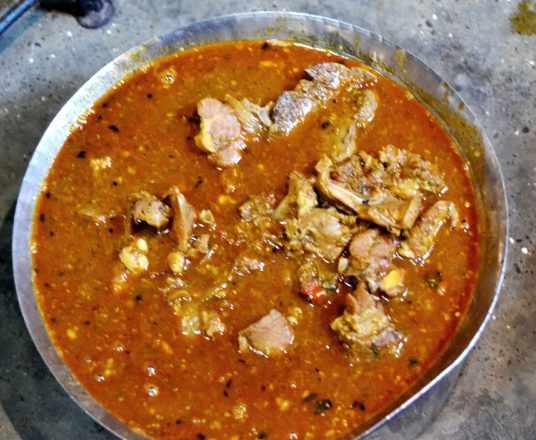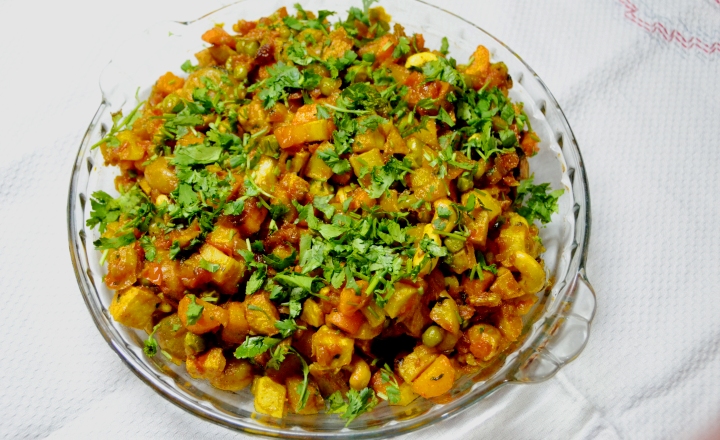
I came across the original recipe of Banjara Mutton many years ago in Pune. When I discovered that one of the construction workers at the restaurant project I was working on was a Lambadi from Mehboob Nagar in Telangana. The Lambadi (also known as Lambada) are a nomadic tribe, part of the Banjara race who were originally from Rajasthan and moved to various parts of India many centuries ago. The Banjara are also linked genetically to the Gypsies of Europe and share many similarities in language and customs. Lambadis are spread across Telangana, Andhra, Karnataka, Tamil Nadu and Maharashtra and speak the Lambadi dialect. In the olden times, they were traders of grain, salt and spices and used to travel from place to place with their entire setup, including livestock.
There is large concentration of Lambadi people in Telangana. Banjara hills in Hyderabad, where all the rich and famous live; used to be where . Now of course, driven to the outskirts because of the real estate boom. The Lambadi of Telangana speak their own dialect, which is also called Lambadi and is mixture of Rajastani and Telugu. Lambadi food is a confluence of local produce and techniques of Telangana where they’ve been staying for a few centuries and of Rajasthan, where they originally came from. Lambadi are meat eaters and the Banjara mutton is their dish of choice.
Ram Singh dresses up like every other guy on the street and looked like just another person in the construction business. I got talking to him and was excited know that he’s a Banjara. This was the first time I met a Banjara and took the liberty of inviting myself for a Lambadi meal at Ram Singh’s house. Most Lambadi are in different fields of work from their ancestors and many of them have become successful. The Lambadi cluster I went to in Pune was small and not very well to do. But one thing that struck me was how clean were their homes. The kitchen was small but each vessel was sparkling like a jewel. No mean feat, considering they were cooking on kerosene stoves, which create an enormous amount of black soot.
The Lambadi are hard working people but also fun. A lot of their activities are community driven. The women have their own separate get togethers and do a lot of craft work as a community including the famous Lambada embroidery. The men sit together and drink as a community ritual. They also cook dinner as part of the drinking ritual. The Lambadi dance is also a wonderful ritual that happens during festivals and marriages.
The way Ram Singh and Devi Bai made Banjara mutton surprised me. I wasn’t expecting this level of technique and complexity in the dish. Here’s the recipe
Serves 2-3 people
Preparation time – 10 to 12 minutes
Cooking time – 60 to 70 minutes
Goat / Mutton (cut on-the-bone medium size pieces) – 500 grams
Onion (medium sized, thickly sliced) – 2 numbers
Oil (for cooking) – 7 tablespoon or 100 millilitre
Tomato – 2 numbers (small size, made into puree)
Bayleaf (dried) – 1 number (powdered)
Cinnamon – 1 medium stick (around 3 inches, powdered)
Red chilly powder – 1 tablespoon or 15 gram (you can add more than this or less, depending on how spicy you like your food)
Garam masala powder – 2 teaspoon or 10 grams
Salt – 1 tablespoon or 15 grams (or to taste)
Turmeric powder – 1 teaspoon or 5 grams
Water – 2 cups or 400 ml
Poppy Seed Paste
Poppy Seeds – 1 tablespoon or 15 grams
Chana dal (split Bengal gram) – 2 tablespoon or 30 grams
Ginger – 1 small piece (around 2 inch)
Grind the poppy seeds, chana dal and ginger into a rough paste in a mixer grinder, But the best results are if you make the paste manually in a sit batta.
Coconut Paste
Fresh Coconut – 1 medium size piece (around 4 inches)
Coriander leaf – 5 stalks
Garlic – 8 number individual cloves
Grind together the coconut, coriander leaf and garlic.
Handi / Any cooking vessel that can hold a gravy – 1 number
Ladle (for stirring) – 1 number
Mixer grinder / Food processor – 1 number
Heat the handi and add the sliced onion. No oil to be added at first. When the edges of the onion start to char / turn brown, add oil and fry this for approx 4-5 minutes. Add the coconut and coriander paste and cook for 3-4 minutes. Then add the poppy seed paste and cook for another 3-4 minutes. Add the tomato puree and cook for 8-10 minutes. The bayleaf and cinnamon powders to be added and cooked for around 1 minute. Add the garam masala powder and salt and cook for another 1 minute. Now add the mutton pieces and cook with the masala mixture for 6-7 minutes. Add water and cook for around 30-45 minutes on medium heat, till mutton pieces are cooked and tender. Finally add the turmeric powder and cook for 1 minute before taking off the fire.
You can also cook in a pressure cooker instead of an open handi. The mutton pieces should get cooked in 10-15 minutes (around 5-6 whistles), depending on the quality of the meat.
Happy cooking and chowder-on!
Categories:
Tags:
Chicken Rajpipla – A Royal Recipe From Gujarat

Parsi Lagan Nu Stew Recipe – A Classic Wedding Dish